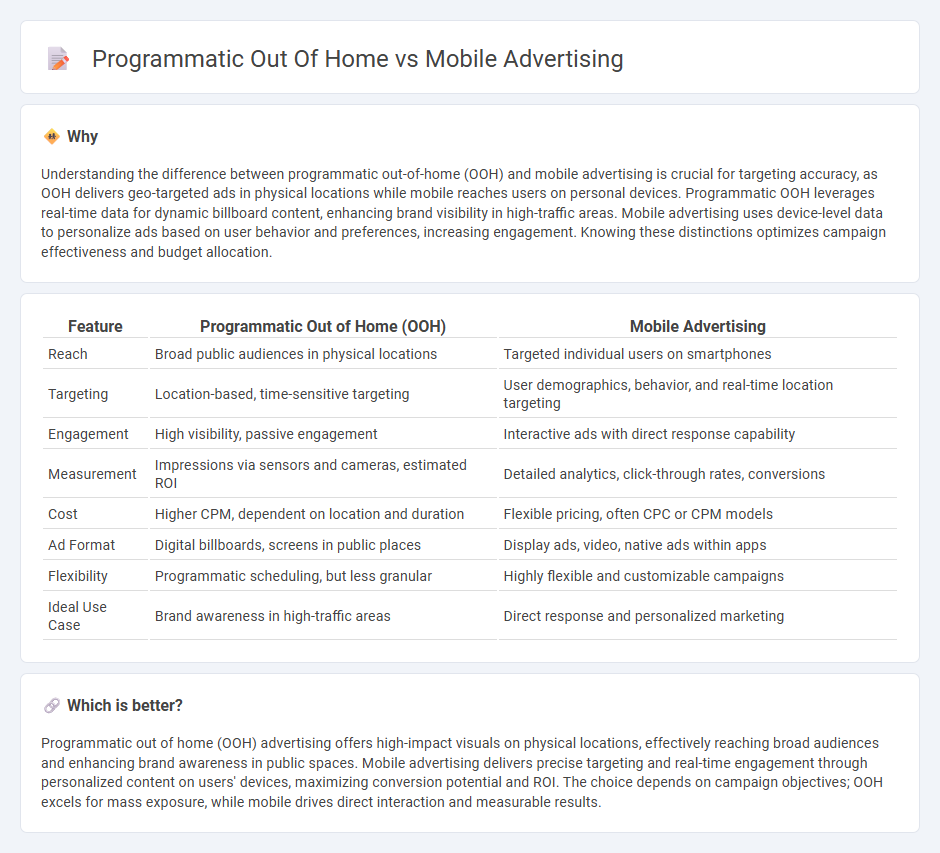
Programmatic Out of Home (OOH) advertising leverages automated technology to deliver targeted digital ads on physical billboards and screens, maximizing real-time audience reach in high-traffic locations. Mobile advertising utilizes data-driven strategies to serve personalized ads directly to users' smartphones and tablets, enhancing engagement through location and behavior-based insights. Explore the distinct advantages of programmatic OOH and mobile advertising to optimize your marketing campaigns effectively.
Why it is important
Understanding the difference between programmatic out-of-home (OOH) and mobile advertising is crucial for targeting accuracy, as OOH delivers geo-targeted ads in physical locations while mobile reaches users on personal devices. Programmatic OOH leverages real-time data for dynamic billboard content, enhancing brand visibility in high-traffic areas. Mobile advertising uses device-level data to personalize ads based on user behavior and preferences, increasing engagement. Knowing these distinctions optimizes campaign effectiveness and budget allocation.
Comparison Table
| Feature | Programmatic Out of Home (OOH) | Mobile Advertising |
|---|---|---|
| Reach | Broad public audiences in physical locations | Targeted individual users on smartphones |
| Targeting | Location-based, time-sensitive targeting | User demographics, behavior, and real-time location targeting |
| Engagement | High visibility, passive engagement | Interactive ads with direct response capability |
| Measurement | Impressions via sensors and cameras, estimated ROI | Detailed analytics, click-through rates, conversions |
| Cost | Higher CPM, dependent on location and duration | Flexible pricing, often CPC or CPM models |
| Ad Format | Digital billboards, screens in public places | Display ads, video, native ads within apps |
| Flexibility | Programmatic scheduling, but less granular | Highly flexible and customizable campaigns |
| Ideal Use Case | Brand awareness in high-traffic areas | Direct response and personalized marketing |
Which is better?
Programmatic out of home (OOH) advertising offers high-impact visuals on physical locations, effectively reaching broad audiences and enhancing brand awareness in public spaces. Mobile advertising delivers precise targeting and real-time engagement through personalized content on users' devices, maximizing conversion potential and ROI. The choice depends on campaign objectives; OOH excels for mass exposure, while mobile drives direct interaction and measurable results.
Connection
Programmatic Out of Home (OOH) and Mobile advertising are interconnected through real-time data integration, enabling precise audience targeting and dynamic content delivery. Leveraging location-based data and consumer behavior insights, campaigns synchronize messaging across physical billboards and mobile devices for cohesive brand experiences. This fusion maximizes engagement by reaching users contextually on the go, enhancing conversion rates and return on ad spend.
Key Terms
Geotargeting
Mobile advertising leverages GPS and location data to deliver hyper-relevant ads directly to users on their smartphones, maximizing engagement through precise geotargeting. Programmatic out-of-home (OOH) advertising uses automated, data-driven platforms to display targeted ads on digital billboards and screens based on audience location, time, and demographics, enhancing reach in specific geographic areas. Explore the evolving techniques and benefits of geotargeting in mobile and programmatic OOH advertising to optimize your marketing strategy.
Real-time bidding (RTB)
Mobile advertising leverages real-time bidding (RTB) to target specific audiences based on location, behavior, and device data, enhancing engagement and conversion rates. Programmatic out of home (OOH) uses RTB to automate ad placements across digital billboards and screens, optimizing impressions and ad spend in real-time. Explore the advantages and implementation strategies of RTB in mobile and programmatic OOH to maximize advertising effectiveness.
Audience segmentation
Mobile advertising leverages precise audience segmentation using real-time data such as location, behavior, and demographics to deliver highly personalized ads. Programmatic out-of-home (OOH) advertising utilizes advanced algorithms and data integration to target specific audience segments based on factors like foot traffic patterns and contextual relevance. Explore how these segmentation techniques can maximize your advertising ROI and campaign effectiveness.
Source and External Links
What Is Mobile Advertising? How To Use Mobile Ads (2024) - Mobile advertising is marketing that targets phone and tablet users through mobile browsers, apps, social media platforms, text messages, and more, allowing precise demographic and location targeting to reach audiences effectively across devices.
Mobile advertising: What is it, and why is it important? - Mobile advertising is a multichannel strategy used by marketers to reach consumers on smartphones and tablets, facilitating real-time messaging and engagement by meeting audiences where they spend time most.
What is Mobile Advertising? Benefits, Types & Tips - Mobile advertising specifically targets users on smartphones or tablets, offering cost-effective, highly segmented, and easily trackable campaigns that adapt through continual optimization to increase engagement and ROI.
 dowidth.com
dowidth.com